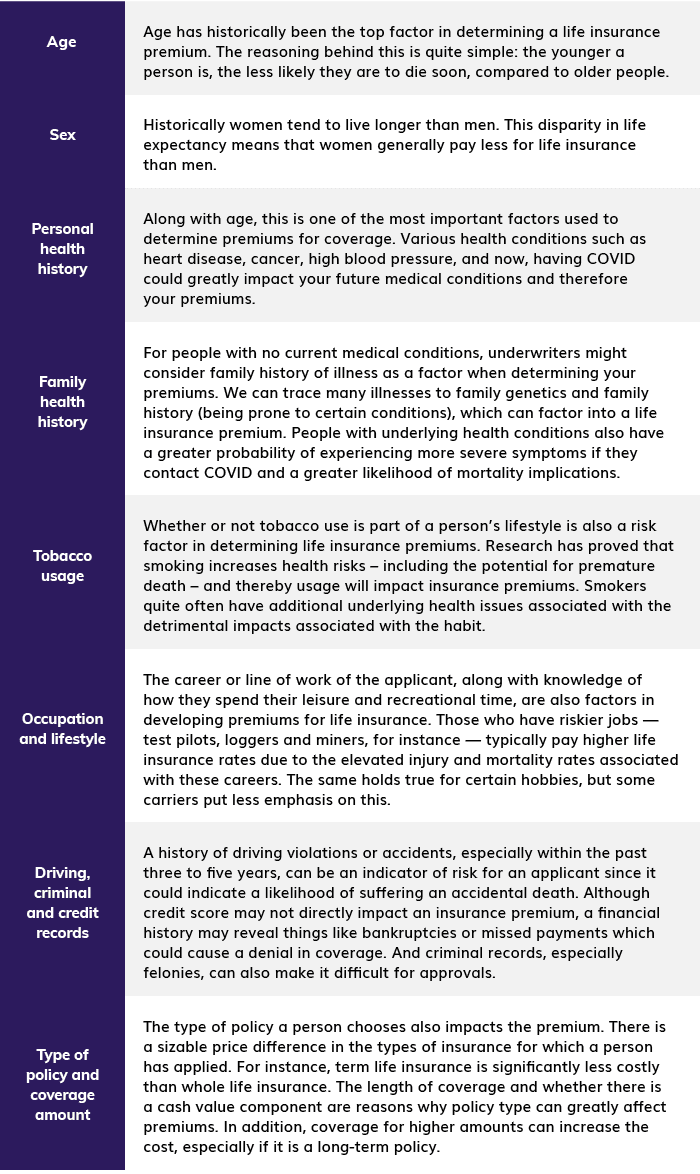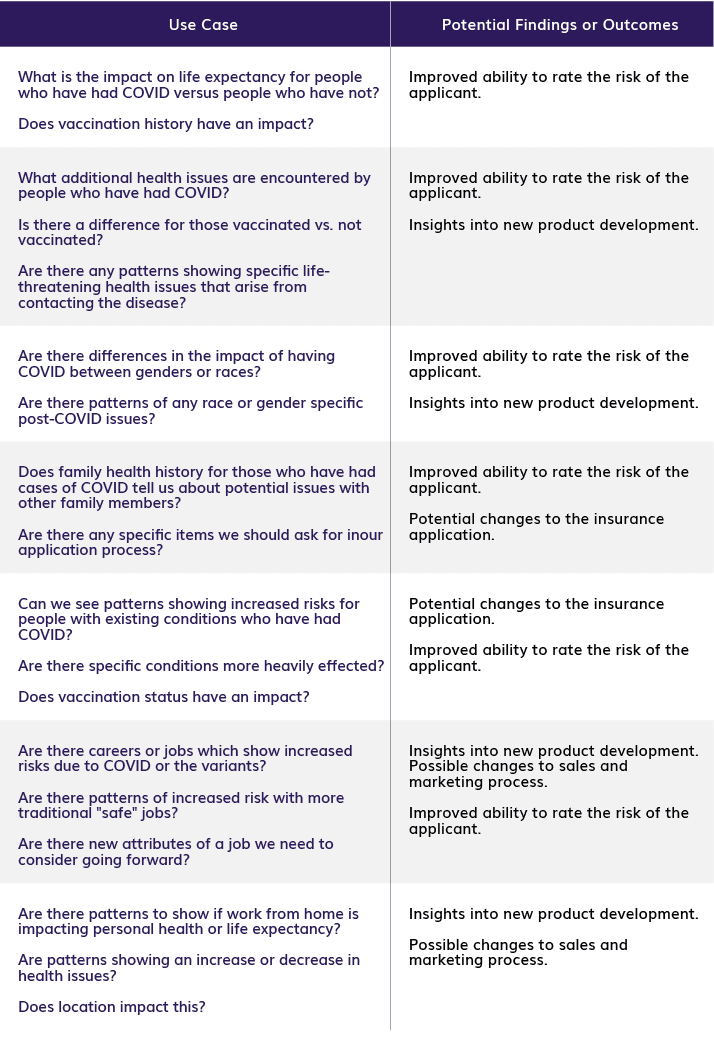We discuss the effects of COVID on the life insurance and annuity industry and provide a solution to improve processes using machine learning and artificial intelligence.
In the first year of COVID, life expectancy dropped by two years on average, and we still don’t fully know the actual impact and variants of the virus. We originally thought it would be gone by the end of 2020, but with numerous mutations, it’s evident the virus will be with us for some time to come. One specific impact is how the insurance industry approaches life and annuity underwriting in the wake of the pandemic.
We may never know how many deaths the virus indirectly or directly caused during the peak of the pandemic. People have also experienced many health complications, and we do not know the long-term impact of issues on life expectancy. These factors complicate things for the insurance industry, specifically Underwriters. However, this area is where machine learning (ML) can help underwriters, along with actuaries and data scientists, predict the longer-term impact of COVID. ML will also enable actuaries and underwriters the ability to incorporate factors resulting from COVID into their assessments, which will help them to provide more reflective actuarial tables.
In the second part of this two-part series, we look at the impact of the virus on the life insurance and annuity industry.
New Considerations for Life Insurance and Annuity
Johns Hopkins provides a running total of COVID cases, and as of the middle of December 2022 worldwide, we were up to over 655 million reported cases, over 6.67 million deaths and over 13 billion doses of vaccine administered. People thought this virus was going to be short-term, yet as CEO Scott Davison of OneAmerica says pandemic deaths were up 40 percent in the third quarter of 2021. We can’t attribute all these deaths to the contacting event – many were after the patient had “recovered.”
Life expectancy projections resulting from COVID have seen an overall drop by roughly 2.9 years and by 2.27 for men and 1.61 for women in the United States. This doesn’t count deaths associated with health complications from people who recovered from COVID. Another factor potentially impacting life expectancy are continuous mutations.
We also don’t know the long-term health impacts associated with people who were not vaccinated versus people who were vaccinated. Will people who were vaccinated have a higher life expectancy? Will people who were not vaccinated have higher overall healthcare costs, and will their life expectancy be less, or will there be unexpected long-term health consequences from taking the vaccine? We still have many unanswered questions at this point.
The pandemic has had a significant impact on life insurance underwriting. Many insurance companies have temporarily changed their underwriting guidelines to accommodate the unique challenges and risks the pandemic presented. Traditionally, there are many factors underwriters use to determine policy and pricing. The following are examples of the most common ones:
These are the more common factors an underwriter will check, but there are others, such as the applicant’s income, weight, alcohol habits, amount of foreign travel and any additional insurance policy riders for which they applied.
Along with regular consideration of the above factors, underwriters must now think about whether COVID contributes to the results of some of these factors. We can also break these effects into sub-groups:
- Those vaccinated who did or did not have COVID.
- Those unvaccinated who did or did not have COVID.
Segmenting these individual groups and diving deeper into their history could help predict future results. It is also highly likely as developers build ML models to consider these new conditions, we will see additional factors surface.
How AI and ML Can Help Life Insurance and Annuity
High death rates, long-term complications from the virus, continued mutations and economic impacts are only some of the factors that will impact life insurance policies. The insurance industry has increasingly focused on leveraging ML and AI for their data scientists and actuaries. For life insurance carriers, many critical processes can benefit from modern ML models, including underwriting and claims.
Using machine learning and artificial intelligence techniques can improve the accuracy of projections of life expectancy and healthcare costs. By training a model on a large dataset of relevant factors and outcomes, it can learn to make more accurate predictions than possible using traditional statistical methods alone. There are several foundational models and different machine learning algorithms carriers could use for this purpose, and the choice of which one will depend on the specific use cases and characteristics of the data and the desired accuracy of the predictions.
Some potential factors insurers could include as inputs to a machine learning model for predicting life expectancy and healthcare costs might include demographic information (such as age and sex), medical history, lifestyle factors (such as diet and exercise habits), and environmental factors (such as air quality and access to healthcare).
Insurers should incorporate predictive (machine learning and artificial intelligence) techniques into their solutions to provide more accurate projections of life expectancy and healthcare costs.
Using ML in Underwriting
Let’s continue our focus on the underwriting process for life insurance and annuity. The heavy reliance on external data sources and the time it takes to gather and analyze data already leads to a slow process. The addition of COVID-related impacts to that data will certainly add time. We can add automation with machine learning algorithms, which we can train to analyze large amounts of data and decide whether to approve or reject a life insurance application or at least provide summarized recommendations to the underwriter.
This analysis can help underwriters save time and effort, as they won’t have to manually review every application. Adoption of ML and AI models can help quicken the pace of the process and allow underwriters, actuaries, and data scientists the ability to bring in additional COVID-related information.
The following table contains some recommended use cases to consider for underwriting and other processes underwriters, actuaries and data scientists see most frequently. Possible data sources for AI and ML to pull from include government and scientific statistics, personal and family health history, MIB, submission data, claims data and social media.
These are only a few examples of use cases for life insurance and annuity to which carriers can start to pay more attention. And remember, life expectancy also plays a part in underwriting annuity contracts.
Conclusion
The recent pandemic has posed significant challenges to the insurance industry, especially in life and annuity underwriting. However, machine learning integration can help underwriters incorporate COVID-related factors, improve projections and streamline processes. Despite the challenges posed by the pandemic, adopting AI and ML techniques offers a path forward for the insurance industry to navigate the evolving landscape.



